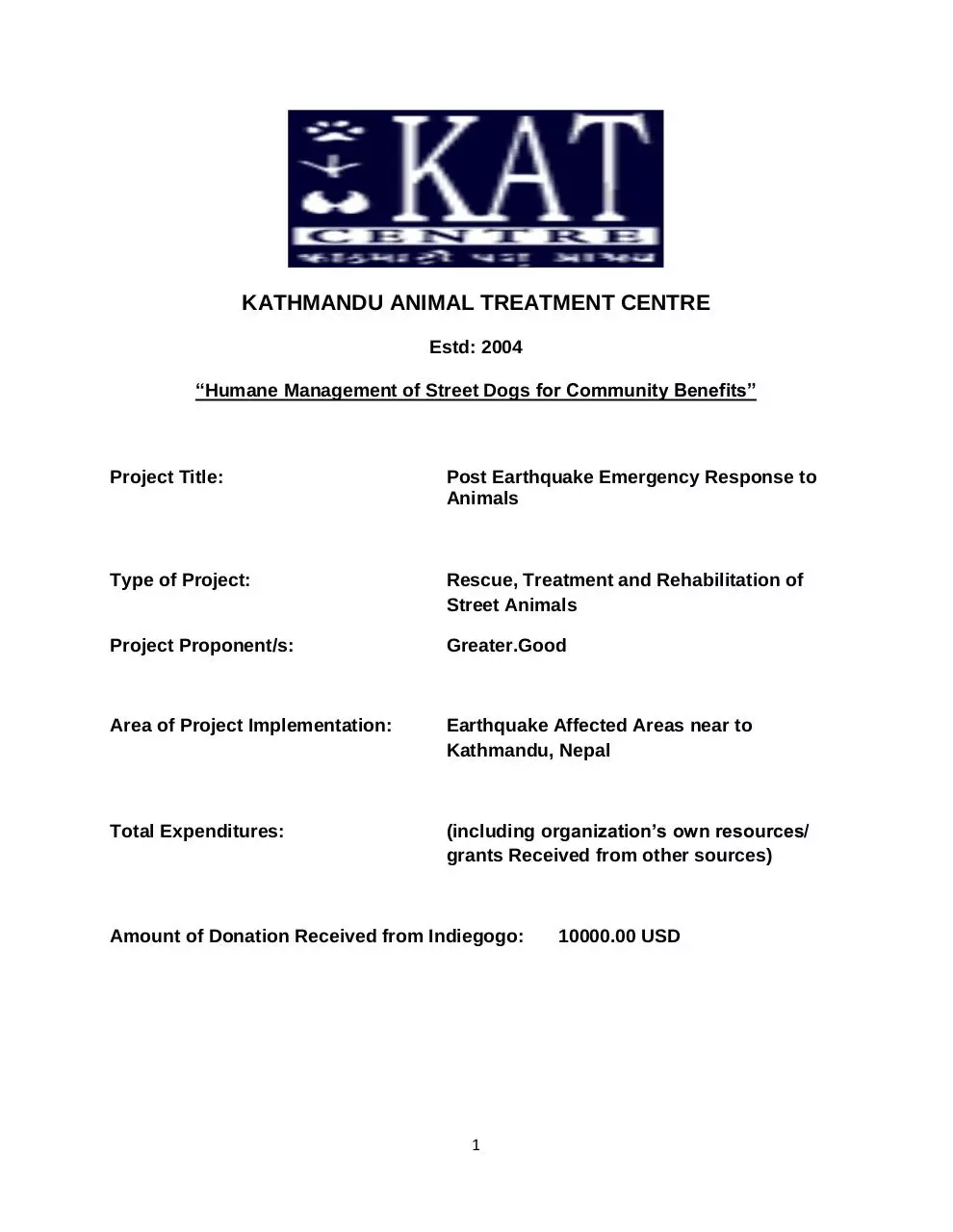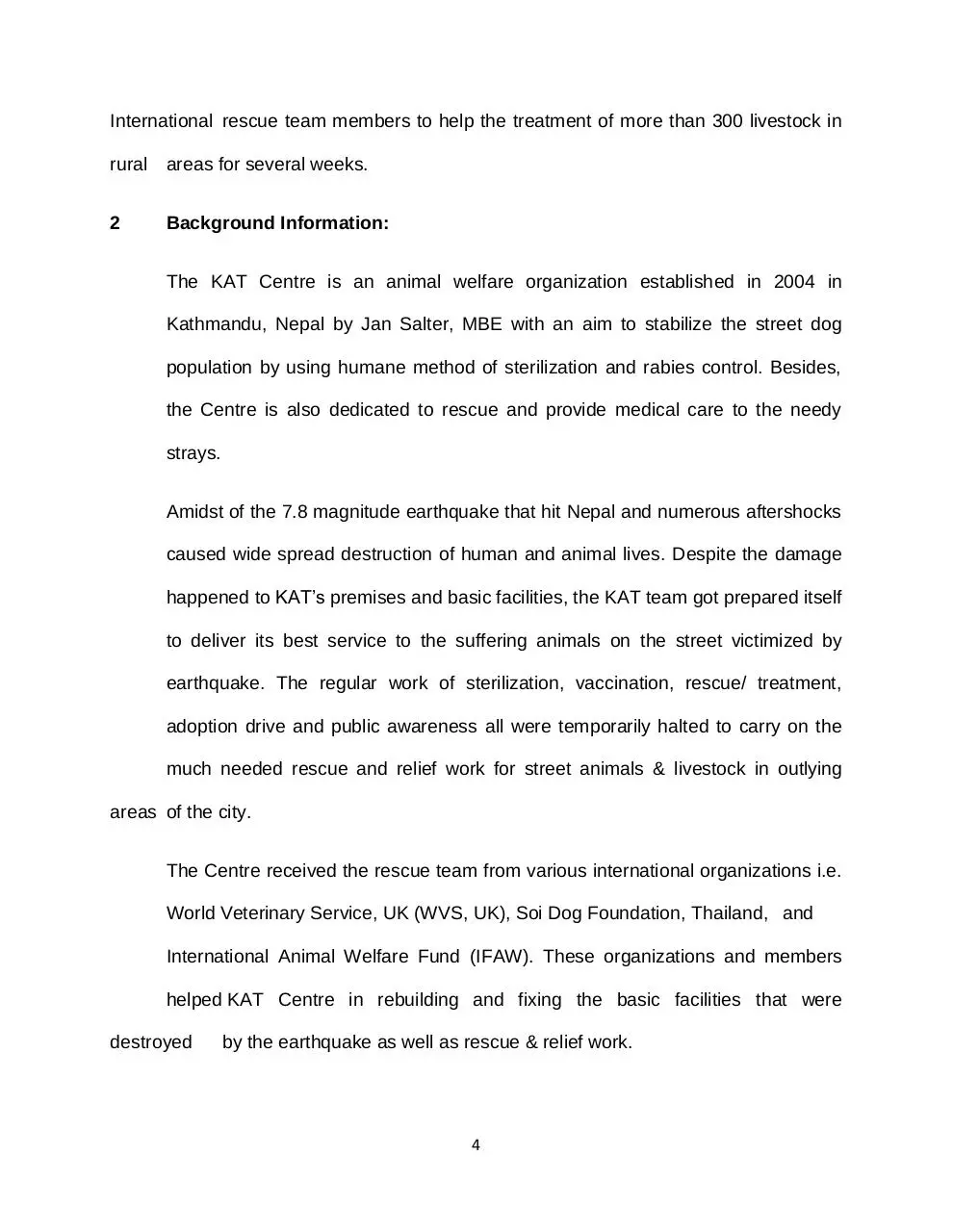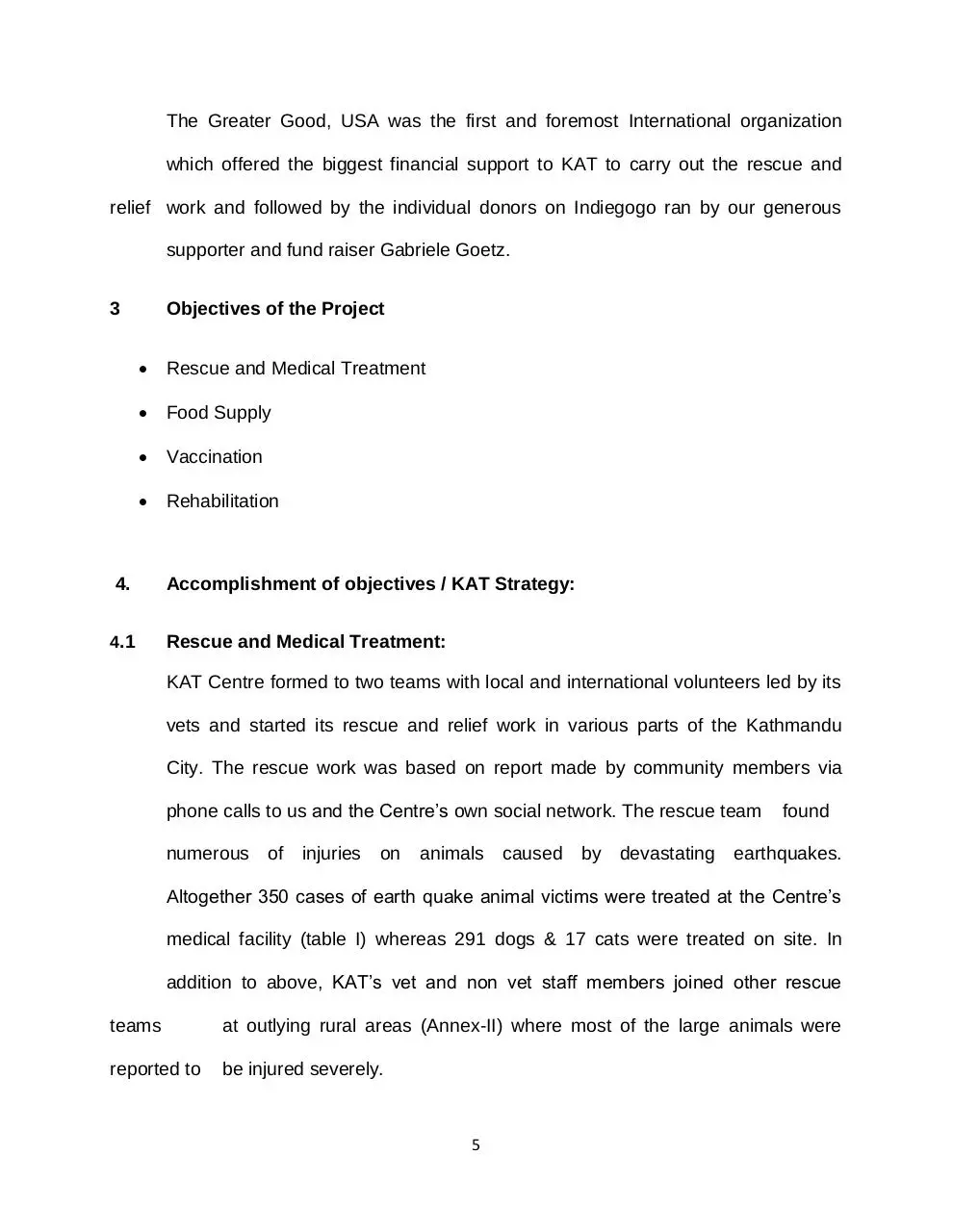Earthquake Rescue Report KAT 2015 final (PDF)
File information
Author: Dell
This PDF 1.5 document has been generated by Microsoft® Word 2013, and has been sent on pdf-archive.com on 10/10/2015 at 10:16, from IP address 84.131.x.x.
The current document download page has been viewed 449 times.
File size: 1.98 MB (16 pages).
Privacy: public file





File preview
KATHMANDU ANIMAL TREATMENT CENTRE
Estd: 2004
“Humane Management of Street Dogs for Community Benefits”
Project Title:
Post Earthquake Emergency Response to
Animals
Type of Project:
Rescue, Treatment and Rehabilitation of
Street Animals
Project Proponent/s:
Greater.Good
Area of Project Implementation:
Earthquake Affected Areas near to
Kathmandu, Nepal
Total Expenditures:
(including organization’s own resources/
grants Received from other sources)
Amount of Donation Received from Indiegogo:
1
10000.00 USD
ACKNOWLEDGEMENTS
This project consumed huge amount work and dedication. Still implementation would not
have been possible if we did not have immediate financial support of Greater. Good,
many individuals from Indiegogo and other organizations. Therefore we would like to
extend our sincere gratitude to all of them.
First of all we are thankful to Greater.Good, IFAW, Dogs Trust, HSI, SPCAI, SPACAIHongkong, and WVS for their financial and logistical support and providing necessary
guidance concerning project implementation.
We would like to express our deep sense of thanks towards volunteers who devoted
their time and knowledge in the implementation of this rescue / relief project.
Nevertheless, we express our gratitude toward our founder Jan Salter, MBE, Gabriele
Goetz, Dawn Sailor and many other individuals, families and colleagues for their kind
cooperation and encouragement which help us in completion of this project.
2
1.
EXECUTIVE SUMMARY:
Nepal suffered a magnitude of 7.8 and 7.6 devastating earthquakes respectively
on 25th April and 12th May, 2015 leaving numerous animals suffer. There were
many animals that were in desperate situation and Kathmandu Animal Treatment
Centre (KAT Centre) was on the ground immediately following the
first
big
earthquake happened to rescue and help the animals. The KAT Centre Rescue
team realizes that there was a huge need for life saving veterinary work for street
animals, companion and livestock.
The two teams of KAT Centre comprised of local and international volunteers and
led by experienced and skilled veterinarians moved to the different parts of the
collapsed city to expedite the rescue work within the Kathmandu Valley and
outlying areas. The Centre’s team was quite busy with rescue and treatment of
animals for two months. The animal rescue was carried out by following ways:
a)
Rescue and Relief
b)
Medical Treatment
c)
Rehabilitation
d)
Food supply
e)
Vaccination
So far 350 street dogs were rescued and treated at the Centre and 291 strays
were treated on site over the 60 days amidst of post earthquake shocks.
Moreover,
Staff members of KAT rescue team were also able to help other
3
International rescue team members to help the treatment of more than 300 livestock in
rural areas for several weeks.
2
Background Information:
The KAT Centre is an animal welfare organization established in 2004 in
Kathmandu, Nepal by Jan Salter, MBE with an aim to stabilize the street dog
population by using humane method of sterilization and rabies control. Besides,
the Centre is also dedicated to rescue and provide medical care to the needy
strays.
Amidst of the 7.8 magnitude earthquake that hit Nepal and numerous aftershocks
caused wide spread destruction of human and animal lives. Despite the damage
happened to KAT’s premises and basic facilities, the KAT team got prepared itself
to deliver its best service to the suffering animals on the street victimized by
earthquake. The regular work of sterilization, vaccination, rescue/ treatment,
adoption drive and public awareness all were temporarily halted to carry on the
much needed rescue and relief work for street animals & livestock in outlying
areas of the city.
The Centre received the rescue team from various international organizations i.e.
World Veterinary Service, UK (WVS, UK), Soi Dog Foundation, Thailand, and
International Animal Welfare Fund (IFAW). These organizations and members
helped KAT Centre in rebuilding and fixing the basic facilities that were
destroyed
by the earthquake as well as rescue & relief work.
4
The Greater Good, USA was the first and foremost International organization
which offered the biggest financial support to KAT to carry out the rescue and
relief work and followed by the individual donors on Indiegogo ran by our generous
supporter and fund raiser Gabriele Goetz.
3
Objectives of the Project
Rescue and Medical Treatment
Food Supply
Vaccination
Rehabilitation
4.
Accomplishment of objectives / KAT Strategy:
4.1
Rescue and Medical Treatment:
KAT Centre formed to two teams with local and international volunteers led by its
vets and started its rescue and relief work in various parts of the Kathmandu
City. The rescue work was based on report made by community members via
phone calls to us and the Centre’s own social network. The rescue team
numerous of
injuries on
animals caused
found
by devastating earthquakes.
Altogether 350 cases of earth quake animal victims were treated at the Centre’s
medical facility (table I) whereas 291 dogs & 17 cats were treated on site. In
addition to above, KAT’s vet and non vet staff members joined other rescue
teams
at outlying rural areas (Annex-II) where most of the large animals were
reported to
be injured severely.
5
Table I: Rescue and Treatment at the Centre
S.N. Type of Illness
Numbers
Recovered
1
Simple Fracture
16
16
2
Complicated Fracture
23
19
4
4
3
Multiple deep Wounds
53
47
6
6
4
Superficial wounds
73
73
-
-
5
Malnutrition and dehydration 68
59
-
9
6
Infectious conditions
83
76
-
7
7
Unknown etiology
34
31
-
3
Grand Total
350
10
29
311
Euthanized Died
Figure 1: Number of different age and sex groups rescued (total of 350)
6
Male
4.2
Food Supply:
The Centre’s rescue team observed that the dogs were striving hard to find the
food in their territory because the people and community members who had been
taking care of street animals on the streets were affected by the earthquakes and
not able to provide food. Another important factor that the team noticed was
common place and sources where the dogs used to get their food i.e. restaurants,
slaughter houses were closed and there were no chances of getting any left- over
or scraps on which the strays usually live on. The Centre distributed food to the
most vulnerable population wherever it was possible for the entire time of crisis of
90 days (See photographs- Annex-II).
4.3
Vaccination Campaign:
The Centre organized vaccination camps against rabies and infectious diseases
(distemper/ parvo) in various places to protect stray animals from severe
diseases.
Altogether 1100 dogs and cats were vaccinated during the rescue phase
(Annex-3
showing the places in the map).
7
4.4
Rehabilitation:
This part of the rescue and relief work is the most difficult part of Centre’s
mission.
There were several pets abandoned by the owners because of emergency.
Most of
the families shifted to other safer parts of the country leaving their pets
behind on
the street. There were over 100 abandoned cases. The Centre rescued
and kept
them either in the Centre’s facility or found a foster family for the
abandoned pets.
The pets were either re-home or reunited with their owners. (Annex
4).
5.
FINANCIAL ASPECT/ BUDGET UTILIZATION
Table II
6.
Summary of the Budget:
Line Items
Spent ( in Nrs)
Spent (in USD)
Medicines
400,000.00
4000.00
Disinfectants and
Vaccines
150,000.00
1500.00
Fuel
150,000.00
1500.00
Food Items ( Rice and
Pedigree)
150,000.00
1500.00
Staff Wages
150,000.00
1500.00
Grand Total
1000,000.00
10000.00
Monitoring and Evaluation:
In order to support the earthquake response for the stray animals, The KAT
established an overall results-based monitoring and reporting system, including a
mechanism for communicating with local community groups which have been
8
supported by the Centre for the welfare of stray animals.
This was meant to
improve responsiveness and adjust strategies as per the needs identified by the
communities and the Centre. In addition, review meetings with community
partners
were held regularly to review progress, challenges, lessons learned and to
develop
an exit strategy in the transition phase. An impact evaluation is planned for
the end
of 2015.
7.
Donors and Partners
Aside from the generous contributions of Greater Good, KAT mobilized internal
support through its own resources, individual donations through crowd funding
page Indiegogo and also other organizations i.e. SPCA International, IFAW,
WVS, HSI, and Dogs Trust UK helped the Centre.
8.
Conclusion
The KAT Centre is always busy with rescue calls from the community but it was
overwhelmed during the earthquake and we tried to accommodate every request
despite the Centre’s limited physical facilities. However, there are still a large
number of stray dogs that need help. The Centre is still striving hard to
handle
the abandoned dogs, infectious causes and malnutrition issues in the stray
animals, few of above mentioned conditions are attributable to earthquake. The
Centre will need continuous support from its well wishers and generous donors to
continue its mission.
9
Download Earthquake Rescue Report KAT 2015 final
Earthquake_Rescue_Report_KAT_2015 final.pdf (PDF, 1.98 MB)
Download PDF
Share this file on social networks
Link to this page
Permanent link
Use the permanent link to the download page to share your document on Facebook, Twitter, LinkedIn, or directly with a contact by e-Mail, Messenger, Whatsapp, Line..
Short link
Use the short link to share your document on Twitter or by text message (SMS)
HTML Code
Copy the following HTML code to share your document on a Website or Blog
QR Code to this page

This file has been shared publicly by a user of PDF Archive.
Document ID: 0000307175.